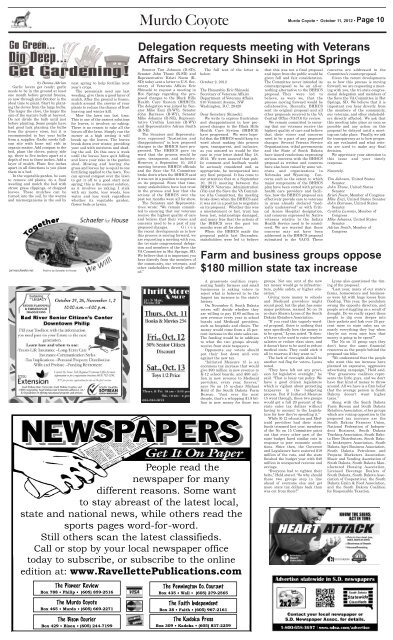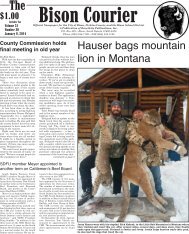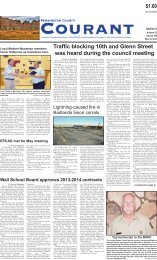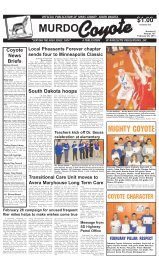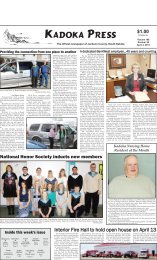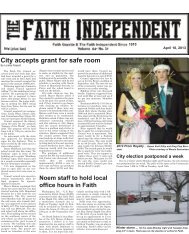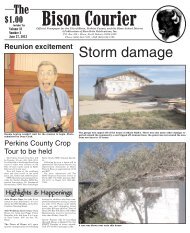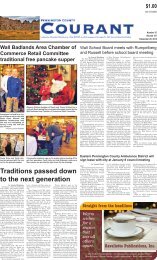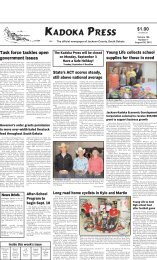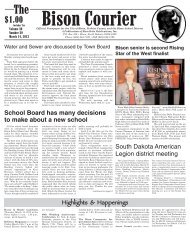E-Coyote_10-11-12_Layout 1.pdf - Pioneer Review
E-Coyote_10-11-12_Layout 1.pdf - Pioneer Review
E-Coyote_10-11-12_Layout 1.pdf - Pioneer Review
You also want an ePaper? Increase the reach of your titles
YUMPU automatically turns print PDFs into web optimized ePapers that Google loves.
Murdo <strong>Coyote</strong><br />
Murdo <strong>Coyote</strong> • October <strong>11</strong>, 20<strong>12</strong> • Page <strong>10</strong><br />
by Donna Adrian<br />
Garlic lovers get ready; garlic<br />
needs to be in the ground at least<br />
one month before ground freezes,<br />
so now through mid-October is the<br />
ideal time to plant. Start by planting<br />
the cloves from the large bulbs.<br />
The larger the clove, the larger the<br />
size of the mature bulb at harvest.<br />
Do not divide the bulb until just<br />
before planting. Some people have<br />
had good luck planting the bulbs<br />
from the grocery store, but it is<br />
recommended to buy your bulbs<br />
from a supplier. Garlic needs fullsun<br />
site with loose soil rich in<br />
organic matter. Add compost to the<br />
bed, plant the cloves, pointy side<br />
up, three to five inches apart at a<br />
depth of two to three inches. Add a<br />
layer of mulch. Plant five inches<br />
apart in all directions is you plant<br />
them in a bed.<br />
In the vegetable garden, be sure<br />
to remove old plants, do a final<br />
weeding and mulch the bed with<br />
straw, grass clippings, or chopped<br />
leaves. These mulches can be<br />
turned into the soil, by the worms<br />
and microorganisms in the soil by<br />
Paid for by Schaefer for House<br />
next spring to help fertilize next<br />
year’s crops.<br />
The perennials need one last<br />
weeding, give them a good layer of<br />
mulch. After the ground is frozen,<br />
mulch around the crowns of your<br />
plants to reduce the chance of frost<br />
heaving and winter kill.<br />
Mow the lawn one last time.<br />
This is one of the easiest solutions<br />
for leaves, it involves no raking.<br />
There is no reason to rake all the<br />
leaves off the lawn. Simply run the<br />
mower at a high setting it will<br />
break up the leaves. The leaves<br />
break down over winter, providing<br />
your soil with nutrients and shading<br />
the soil. Do this once a week<br />
until the leaves have quit falling<br />
and leave your rake in the garden<br />
shed. Mowing and leaving the<br />
grass and leaves lay is equal to one<br />
fertilizing applied to the lawn. You<br />
can spread compost over the lawn<br />
to get it off to a good start next<br />
spring; this is the easiest solution,<br />
as it involves no raking. I stick<br />
with my motto, less weeds, less<br />
water and less work regardless<br />
whether its vegetable garden,<br />
flower beds or lawns.<br />
Delegation requests meeting with Veterans<br />
Affairs Secretary Shinseki in Hot Springs<br />
Senator Tim Johnson (D-SD),<br />
Senator John Thune (R-SD) and<br />
Representative Kristi Noem (R-<br />
SD) today sent a letter to U.S. Secretary<br />
of Veterans Affairs Eric<br />
Shinseki to request a meeting in<br />
Hot Springs regarding the proposed<br />
changes to the Black Hills<br />
Health Care System (BHHCS).<br />
The delegation was joined by Senator<br />
Mike Enzi (R-WY), Senator<br />
John Barrasso (R-WY), Senator<br />
Mike Johanns (R-NE), Representative<br />
Cynthia Lummis (R-WY)<br />
and Representative Adrian Smith<br />
(R-NE).<br />
The Senators and Representatives<br />
expressed “frustration and<br />
disappointment” in how proposed<br />
changes to the BHHCS have progressed.<br />
The BHHCS gave its<br />
word that the process would be<br />
open, transparent, and inclusive.<br />
However, a September <strong>10</strong>, 20<strong>12</strong><br />
meeting between BHHCS officials<br />
and the Save the VA Committee<br />
broke down when the BHHCS said<br />
it was not in a position to negotiate<br />
on its proposal. Since that time,<br />
many stakeholders have lost trust<br />
in the process and fear that the<br />
actions of the BHHCS over the<br />
past ten months were all for show.<br />
The Senators and Representatives<br />
wrote: “We remain committed<br />
to ensuring that our veterans<br />
receive the highest quality of care<br />
and believe that their voices and<br />
concerns need to be a part of any<br />
proposed changes. G i v e n<br />
the recent developments as to how<br />
this process is moving forward, we<br />
are requesting a meeting with you,<br />
the tri-state congressional delegation<br />
and members of the Save the<br />
VA Committee in Hot Springs, SD.<br />
We believe that it is important you<br />
hear directly from the members of<br />
the community, our veterans, and<br />
other stakeholders directly affected.”<br />
The full text of the letter is<br />
below:<br />
October 2, 20<strong>12</strong><br />
The Honorable Eric Shinseki<br />
Secretary of Veterans Affairs<br />
Department of Veterans Affairs<br />
8<strong>10</strong> Vermont Avenue, NW<br />
Washington, D.C. 20420<br />
Dear Secretary Shinseki:<br />
We write to express frustration<br />
and disappointment in how proposed<br />
changes to the Black Hills<br />
Health Care System (BHHCS)<br />
have progressed. We were hopeful<br />
that the BHHCS would keep its<br />
word about making this process<br />
open, transparent, and inclusive,<br />
as you assured us would be the<br />
case in your letter dated May 18,<br />
20<strong>12</strong>. We were assured that public<br />
comment and feedback would<br />
be seriously considered and, as<br />
appropriate, be incorporated into<br />
any final proposal. It has come to<br />
our attention that at a September<br />
<strong>10</strong>, 20<strong>12</strong> meeting between the<br />
BHHCS Veterans Administration<br />
(VA) and the Save the VA Committee<br />
(the Committee), the meeting<br />
broke down when the BHHCS said<br />
it was not in a position to negotiate<br />
on its proposal. Whether this was<br />
a misstatement or fact, trust has<br />
been lost, relationships damaged,<br />
and many fear that the actions of<br />
the BHHCS over the past ten<br />
months were all for show.<br />
When the BHHCS made the<br />
proposal public last December,<br />
stakeholders were led to believe<br />
that this was not a final proposal<br />
and input from the public would be<br />
given full and fair consideration.<br />
The Committee never intended its<br />
counterproposal to be an all-ornothing<br />
alternative to the BHHCS<br />
proposal. They were led to<br />
believe, as were we, that the<br />
process moving forward would be<br />
collaborative. Recently, BHHCS<br />
sent its original proposal and all<br />
other proposals received to the VA<br />
Central Office (VACO) for review.<br />
We remain committed to ensuring<br />
that our veterans receive the<br />
highest quality of care and believe<br />
that their voices and concerns<br />
need to be a part of any proposed<br />
changes. Several Veteran Service<br />
Organizations, tribal governments<br />
and the State of South Dakota<br />
have issued resolutions expressing<br />
serious concerns with the BHHCS<br />
proposal as written and concerns<br />
have also been raised by some veterans<br />
and organizations in<br />
Nebraska and Wyoming. Concerns<br />
such as the extent to which<br />
major components of the BHHCS<br />
plan have been vetted with private<br />
health care providers and facilities,<br />
how the BHHCS proposal can<br />
effectively provide care to veterans<br />
in areas already declared “medically<br />
underserved” or with Critical<br />
Access Hospital designation,<br />
and concerns expressed by Native<br />
veterans relative to the Indian<br />
Health Service need to be considered.<br />
We are worried that these<br />
concerns may not have been<br />
addressed in the BHHCS proposal<br />
submitted to the VACO. These<br />
concerns are addressed in the<br />
Committee’s counterproposal.<br />
Given the recent developments<br />
as to how this process is moving<br />
forward, we are requesting a meeting<br />
with you, the tri-state congressional<br />
delegation and members of<br />
the Save the VA Committee in Hot<br />
Springs, SD. We believe that it is<br />
important you hear directly from<br />
the members of the community,<br />
our veterans, and other stakeholders<br />
directly affected. We ask that<br />
this meeting take place as soon as<br />
possible and any action on this<br />
proposal be delayed until a meeting<br />
can take place. Finally, we ask<br />
for transparency as to how proposals<br />
are evaluated and what criteria<br />
are used to make any final<br />
decision.<br />
We appreciate your attention to<br />
this issue and your timely<br />
response.<br />
Sincerely,<br />
Tim Johnson, United States<br />
Senator<br />
John Thune, United States<br />
Senator<br />
Kristi Noem, Member of Congress<br />
Mike Enzi, United States Senator<br />
John Barrasso, United States<br />
Senator<br />
Cynthia Lummis, Member of<br />
Congress<br />
Mike Johanns, United States<br />
Senator<br />
Adrian Smith, Member of<br />
Congress<br />
Farm and business groups oppose<br />
$180 million state tax increase<br />
People read the<br />
newspaper for many<br />
different reasons. Some want<br />
to stay abreast of the latest local,<br />
state and national news, while others read the<br />
sports pages word-for-word.<br />
Still others scan the latest classifieds.<br />
Call or stop by your local newspaper office<br />
today to subscribe, or subscribe to the online<br />
edition at: www.RavellettePublications.com<br />
The <strong>Pioneer</strong> <strong>Review</strong><br />
Box 788 • Philip • (605) 859-2516<br />
The Murdo <strong>Coyote</strong><br />
Box 465 • Murdo • (605) 669-2271<br />
The Bison Courier<br />
Box 429 • Bison• (605) 244-7199<br />
The Pennington Co. Courant<br />
Box 435 • Wall • (605) 279-2565<br />
The Faith Independent<br />
Box 38 • Faith • (605) 967-2161<br />
A grassroots coalition representing<br />
family farmers and small<br />
businesses is asking voters to<br />
reject what is believed to be the<br />
largest tax increase in the state's<br />
history.<br />
On November 6, South Dakota<br />
voters will decide whether they<br />
are willing to pay $180 million in<br />
new revenue every year to school<br />
boards and Medicaid providers,<br />
such as hospitals and clinics. The<br />
money would come from a 25 percent<br />
increase in the state sales tax.<br />
The funding would be in addition<br />
to what the two groups already<br />
receive from state taxpayers.<br />
Opponents say voters should<br />
put their foot down and vote<br />
against the new tax.<br />
“Initiated Measure 15 is an<br />
enormous tax increase that would<br />
give $90 million in new revenue to<br />
K-<strong>12</strong> school boards, and $90 million<br />
in new revenue to Medicaid<br />
providers, every year, forever,”<br />
says No on 15 co-chair Michael<br />
Held of the South Dakota Farm<br />
Bureau. “Just over the next<br />
decade, that's a whopping $1.8 billion<br />
in new money for those two<br />
The Kadoka Press<br />
Box 309 • Kadoka • (605) 837-2259<br />
groups. Not one cent of the new<br />
tax money would go to infrastructure,<br />
public safety, or higher education.”<br />
Giving more money to schools<br />
and Medicaid providers might<br />
sound good, but the plan has some<br />
major problems, warned No on 15<br />
co-chair Shawn Lyons of the South<br />
Dakota Retailers Association.<br />
“If you read this vaguely-worded<br />
proposal, there is nothing that<br />
says specifically how the money is<br />
to be spent,” Lyons noted. “It doesn't<br />
have to be used to raise teacher<br />
salaries or reduce class sizes, and<br />
it doesn't have to be used to reduce<br />
medical costs. They could stick it<br />
all in reserves if they want to.”<br />
The lack of oversight should be<br />
another red flag for voters, Lyons<br />
noted.<br />
“They have left out any provision<br />
for legislative oversight,” he<br />
said. “That is lousy tax policy. We<br />
have a good citizen legislature<br />
which is vigilant about protecting<br />
taxpayers in the budgeting<br />
process. But if Initiated Measure<br />
15 went through, these two groups<br />
would get a full 20 percent of the<br />
state sales tax dollars without<br />
having to account to the Legislature<br />
for how they're spending it.”<br />
While K-<strong>12</strong> education and Medicaid<br />
providers had their state<br />
funds trimmed last year, members<br />
of the No on 15 Committee point<br />
out that every other part of the<br />
state budget faced similar cuts in<br />
response to poor economic conditions.<br />
Since then, the Governor<br />
and Legislature have restored $18<br />
million of the cuts, and the state<br />
finished the budget year with $48<br />
million in unexpected revenue and<br />
savings.<br />
“Everyone had to tighten their<br />
belts,” Held stated. “So why should<br />
these two groups step in line<br />
ahead of everyone else and get<br />
more state tax dollars back than<br />
was cut from them?”<br />
Lyons also questioned the timing<br />
of the proposal.<br />
“Last year, many of our state's<br />
farms, homeowners and businesses<br />
were hit with huge losses from<br />
flooding. This year, the pendulum<br />
swung the opposite direction, and<br />
people are struggling as a result of<br />
drought. Do we really expect those<br />
people to dig even deeper into<br />
their pockets and fork over 25 percent<br />
more in state sales tax on<br />
nearly everything they buy when<br />
they're not even sure how that<br />
money is going to be spent?”<br />
The No on 15 group says they<br />
don't have the same financial<br />
resources as the people behind the<br />
proposed tax hike.<br />
“We understand that the people<br />
who want this tax increase have<br />
planned an expensive, aggressive<br />
advertising campaign,” Held said.<br />
“Our grassroots coalition represents<br />
the little guys, and we don't<br />
have that kind of money to throw<br />
around. All we have is a firm belief<br />
that the average person in South<br />
Dakota doesn't want higher<br />
taxes.”<br />
Along with the South Dakota<br />
Farm Bureau and South Dakota<br />
Retailers Association, other groups<br />
which are voicing opposition to the<br />
proposed tax increase are the<br />
South Dakota Farmers Union,<br />
National Federation of Independent<br />
Business, South Dakota<br />
Trucking Association, South Dakota<br />
Beer Distributors, South Dakota<br />
Innkeepers Association, South<br />
Dakota Agri-Business Association,<br />
South Dakota Petroleum and<br />
Propane Marketers Association,<br />
Music and Vending Association of<br />
South Dakota, South Dakota Manufactured<br />
Housing Association,<br />
Licensed Beverage Dealers of<br />
South Dakota, South Dakota Association<br />
of Cooperatives, the South<br />
Dakota Grain & Feed Association,<br />
and the South Dakota Coalition<br />
for Responsible Taxation.


